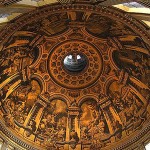Michelangelo and the Pope’s Ceiling
The date was October 31. The year 1512. A few days earlier, Michelangelo had completed the masterpiece he had been working on for the prior four years and four weeks – the fresco on the ceiling of the Sistine Chapel.
Now it was time to celebrate. Pope Julius II had been hosting a banquet for the ambassador of Parma. When the banquet was over – and after a late afternoon nap – the Pope brought the ambassador, seventeen cardinals, and a few others into the newly finished chapel to celebrate vespers.
The reactions were – as one would expect given the ceiling’s place as one of the artistic monuments of the entire western world – very positive.
It was, one said, “a stupendous work.”
Another said “it was such as to make everyone astonished and dumb.”
Everyone except for Pope Julius, that is.
While he surveyed the ceiling “with immense satisfaction,” Julius also had some advice for Michelangelo. The ceiling lacked, in his opinion, “the final touch,” and he asked Michelangelo to retouch the fresco “to give it a richer appearance.”
Michelangelo disagreed, and they had a short debate over the merits of making additional changes. Michelangelo eventually won over the pope, convincing him that no additional “final touches” were necessary.
History seems to have supported the artist’s instincts.
This is the kind of detail that makes Michelangelo and the Pope’s Ceiling such a fascinating and riveting read.
On the one hand, author Ross King shows us the very specific artistic challenges Michelangelo faced in creating his fresco. The challenges of sourcing pigments, for example (the best were from the Gesuati friars at San Giusto alle Mura in Florence), and the difficulties of designing and building scaffolding that would “span a width of forty-four feet and rise some sixty more above the floor.”
On the other hand, King is also able to bring alive the political, military, and economic forces that serve as the backdrop of the creation of this masterpiece – reminding us of the ongoing struggles for power not only within Italy, but also of the tensions between the Papal states and France, England and Spain.
For anyone interested in learning more about the history of the Sistine Chapel’s ceiling, King’s survey of the creation of this most amazing artistic achievement is a must-read.
And for those who, upon finishing it, can’t wait to read something like it, you can be grateful that King also wrote Brunelleschi’s Dome: How a Renaissance Genius Reinvented Architecture. It tells the story of the dome of Florence’s Santa Maria del Fiore, which remains, to this day, the largest masonry dome in the entire world.













No comments